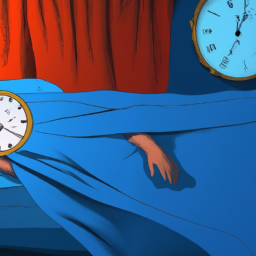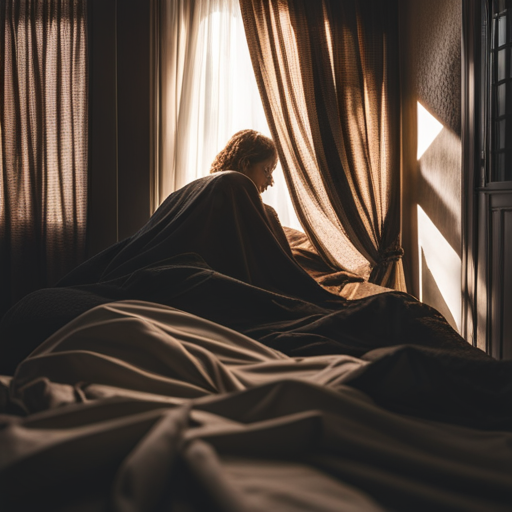Dream Meaning
Why Do Dogs Have Bad Dreams

As someone who owns a dog, I’ve frequently found myself curious about why my furry companion sometimes whimpers or barks while waking up from a sound sleep. It appears that dogs having nightmares is not out of the ordinary, and indeed, there are multiple reasons that play into this occurrence.
First, it’s important to understand the science behind dog dreams. Similar to humans, dogs experience Rapid Eye Movement (REM) sleep, which is when most dreaming occurs. During this stage, their brains are active, and they may experience vivid dreams that can be influenced by a variety of factors, including their daily experiences, breed and personality traits, and even health conditions.
In this article, we’ll explore the reasons why dogs have bad dreams, how to recognize the signs, and what you can do to help your furry friend get a better night’s sleep.
Key Takeaways
- Dogs’ dreams can be influenced by their daily experiences, breed and personality traits, and even health conditions.
- Dogs have a heightened sense of awareness that can detect potential dangers, even while they’re sleeping.
- Factors such as medical conditions, medication side effects, environmental factors, and emotional stimuli can impact the content of a dog’s dreams.
- Providing a comfortable sleep environment, regular exercise and mental stimulation, and natural remedies can help improve a dog’s quality of sleep and prevent sleep disorders.
The Science Behind Dog Dreams
The reason why dogs have bad dreams is because, just like humans, they experience Rapid Eye Movement (REM) sleep. During REM sleep, the brain is highly active and this is when dreams occur. Dogs, just like us, go through cycles of REM sleep throughout the night.
Interestingly, the length of each REM cycle in dogs is much shorter than in humans. This means that they experience more frequent bursts of brain activity and dreams throughout the night. It’s also worth noting that dogs have a greater sensitivity to their environment, which can influence their dreams. For example, if they hear a loud noise or sense danger, it can affect the content of their dreams.
Understanding the science behind dog dreams helps us appreciate them as complex beings and highlights the importance of ensuring they have a comfortable and safe sleeping environment.
As we explore the evolutionary history of dogs, we can see how their sleeping habits have adapted over time.
Evolutionary History
You might be surprised to learn that your furry friend’s nightmares could be a remnant of their wild ancestors’ survival instincts. Evolutionary adaptations have allowed dogs to survive in the wild for thousands of years, and these adaptations have been passed down through generations. One of these adaptations is the ability to react quickly to threats and danger.
This is where genetic influences come into play. Dogs have a heightened sense of awareness that can detect potential dangers, even while they’re sleeping. As a result, dogs are prone to having bad dreams as their brains continue to process information from their surroundings, even while they’re asleep. This may explain why some dogs may bark, whimper, or move around during their sleep.
While domesticated dogs may not have to worry about predators in their daily lives, their genetic makeup still includes these survival instincts. In the next section, we’ll delve into how dogs’ daily experiences may also contribute to their dreams.
Daily Experiences
Imagine your pup’s daily adventures and interactions influencing their subconscious mind while they catch some Z’s. Just like humans, dogs also experience different levels of sleep. The quality of their sleep is affected by their sleep hygiene and nighttime routines. Factors such as a comfortable sleeping environment, regular exercise, and a balanced diet can all contribute to better sleep for your furry friend.
To understand why dogs have bad dreams, it’s important to consider their daily experiences. Dogs are highly social creatures, and they rely on their pack for survival. Their interactions with other dogs, humans, and their environment can all impact their mental and emotional state. These experiences can carry over into their dreams, causing them to have nightmares or bad dreams. As pet owners, it’s important to provide a safe and comfortable environment for our furry friends, to ensure they have the best possible sleep and mental health.
Transitioning into the subsequent section about ‘breed and personality traits’, it’s important to note that certain breeds or individual personality traits may also play a role in a dog’s dreams.
Breed and Personality Traits
As a dog owner, I’ve noticed that my furry friend often twitches and whimpers in his sleep.
I’ve wondered if different breeds have varying dream frequencies and content.
Additionally, I’ve wondered how a dog’s personality traits might affect their dream content.
Understanding these factors could provide insights into the inner world of our canine companions.
Differences in Dream Frequency and Content among Breeds
Discover how your furry friend’s breed could be influencing the frequency and content of their dreams. Dream frequency variability is a common occurrence among dogs, and it largely depends on their breed.
For instance, smaller breeds such as chihuahuas and poodles tend to have more dreams compared to larger breeds like Great Danes and Mastiffs. The dreams of smaller breeds are also more intense, and they tend to wake up more frequently during the night, indicating a higher level of dream activity. On the other hand, larger breeds tend to have fewer dreams that are less intense, and they tend to sleep longer.
Breed-specific dream content is another factor that influences a dog’s dream frequency and intensity. For example, hunting breeds like Beagles and Pointers are more likely to dream about chasing prey, while guard dog breeds like German Shepherds and Rottweilers tend to dream about protecting their owners. Breeds that are more social, such as Golden Retrievers and Labrador Retrievers, tend to dream about playing and interacting with their owners.
Understanding your dog’s breed and specific dream content can help you provide better care and enrich their lives. This ties into the next section about the role of personality traits in dream content.
The Role of Personality Traits in Dream Content
You might be wondering how your dog’s personality affects the content of their dreams, but rest assured that understanding this can lead to a deeper understanding and connection with your furry companion. Dream analysis can be a useful tool for assessing personality traits in dogs. In fact, a recent study found that dogs with higher levels of neuroticism tend to have more negative dreams, while dogs with higher levels of agreeableness tend to have more positive dreams.
To better understand how personality traits influence dream content in dogs, let’s take a look at a table that summarizes the findings of the study:
| Personality Trait | Dream Content |
|---|---|
| Neuroticism | Negative (e.g. fear, anxiety) |
| Agreeableness | Positive (e.g. playfulness, affection) |
| Openness | Unusual (e.g. surreal, bizarre) |
Dream analysis can not only help us gain insight into our dog’s personality, but it can also provide clues about their emotional state and well-being. In the next section, we will explore how health and medical conditions can impact a dog’s dreams.
Health and Medical Conditions
As a researcher in the field of canine psychology, I’ve explored the connection between a dog’s medical conditions and the content of their dreams.
It’s well-known that medical conditions can have a significant impact on a dog’s behavior and mood, but how do these conditions affect their dreams?
Additionally, I’ve studied the impact of medications on dream content and how they can alter the way a dog experiences their dreams.
The Connection between Medical Conditions and Dream Content
Medical conditions can impact the content of a dog’s dreams, just like they can for humans. As a neural network, the brain processes information from the environment and the body to produce dreams. When a dog experiences anxiety, it can manifest in their dreams as well.
Here are some ways that medical conditions can affect a dog’s dream content:
-
Painful sensations: Dogs might dream about the source of their discomfort, such as a sore limb or a digestive issue.
-
Medications: Certain medications can alter a dog’s brain chemistry and influence their dreams.
-
Seizures: Dogs with epilepsy can have vivid dreams that reflect their seizure activity.
-
Hormonal changes: Changes in a dog’s hormone levels can affect their sleep and dream patterns.
-
Dream interpretation: While it’s not possible to directly ask a dog about their dreams, interpreting their body language and vocalizations can give some clues about their dream content.
Understanding how medical conditions can impact a dog’s dreams can help pet owners provide better care for their furry friends. It’s important to note, however, that medication can also have an impact on dream content in dogs.
The Impact of Medications on Dream Content
Drugs can seriously mess with a pup’s dream world, making it all the more important to monitor their medication. Medication side effects, including those for dogs, are often understudied, but they can have a significant impact on a dog’s dream content. The following table outlines some common medication side effects and how they may affect a dog’s dreams.
| Medication Side Effect | Impact on Dream Content |
|---|---|
| Antidepressants | May cause vivid, intense dreams |
| Painkillers | May cause nightmares or disturbing dreams |
| Steroids | May cause vivid, intense dreams or nightmares |
| Sedatives | May cause decreased dream activity |
It’s important to note that these are generalizations, and each dog may react differently to medication. Additionally, interpreting a dog’s dreams can be difficult, given their inability to communicate verbally. However, monitoring changes in behavior and sleep patterns can provide valuable insight into how medication may be affecting a dog’s dream world.
Understanding the impact of medication on a dog’s dreams is just one aspect of ensuring their overall well-being. Environmental factors, such as their sleeping area and daily routine, can also have a significant impact on their dream content.
Environmental Factors
As a dog, I’m sensitive to environmental stimuli that can impact my dream content and overall sleep quality.
Research has shown that external factors such as temperature, sound, and light can influence the content of my dreams.
Additionally, the sleep environment itself can play a role in shaping the content of my dreams.
Certain sleeping arrangements can lead to more positive or negative dream experiences.
Please make sure to double new line after each complete sentence.
The Impact of Environmental Stimuli on Dream Content
Imagine how your dog’s dreams may be influenced by the sights, sounds, and smells they encounter in their everyday environment. Environmental stimuli can significantly impact dream interpretation, and dogs aren’t exceptions. Here are some examples of how environmental factors can affect your dog’s dreams:
-
Visual stimuli: Dogs are very visual creatures, and the things they see during the day can show up in their dreams. For example, if your dog sees a squirrel while on a walk, it’s possible that they may dream about chasing after it.
-
Auditory stimuli: Dogs have excellent hearing, and the sounds they hear can also influence their dreams. For instance, if your dog hears a thunderstorm during the day, they may dream about being scared of thunder at night.
-
Olfactory stimuli: Dogs have a highly developed sense of smell, and the scents they encounter can also impact their dreams. If your dog smells something interesting, like a new type of food or a strange animal, they may dream about it later.
-
Emotional stimuli: Finally, the emotions your dog experiences during the day can play a role in their dream content. If your dog is happy and excited during the day, they may dream about playing and having fun. Conversely, if they’re scared or anxious, they may have more nightmares.
Understanding how environmental stimuli can affect your dog’s dreams is just the first step in unlocking the mystery of why dogs have bad dreams. In the next section, we’ll explore the relationship between dream content and sleep environment to gain even more insight into this fascinating topic.
The Relationship between Dream Content and Sleep Environment
When you’re creating a comfortable sleep environment for your furry companion, it’s essential to understand how their dream content can be influenced by their surroundings. Sleep quality can have a significant impact on dream recall, and environmental factors such as temperature, lighting, and noise levels can all affect how deeply a dog sleeps.
A comfortable sleep environment can result in a deeper and more restful sleep, which can lead to more positive dream content. Temperature is one of the most crucial factors in creating a comfortable sleep environment. Dogs have a higher body temperature than humans, so if the room is too warm, it can cause discomfort and disrupt their sleep. Similarly, if the room is too cold, it can lead to shivering and restlessness. Finding the right balance can help ensure your dog has a peaceful and comfortable sleep, leading to better dream content.
With that said, let’s explore the behavioral signs of bad dreams.
Behavioral Signs of Bad Dreams
You can tell if your dog is having a bad dream by observing their behavioral signs. They may whimper, cry, or even growl in their sleep. Their legs may twitch or they may paddle their paws as if running.
Some dogs may even wake up suddenly and seem disoriented. If you notice these signs, it’s best to let them sleep and not wake them up. Comforting your dog during bad dreams may reinforce the behavior and make it worse in the long run.
It’s important to create a comfortable sleep environment for your dog to help reduce the occurrence of bad dreams. Providing a comfortable bed in a quiet, dark room can help your dog feel safe and secure.
Regular exercise and mental stimulation can also help reduce stress and anxiety, leading to better sleep. By creating a calming environment and providing the necessary physical and mental stimulation, you can help your dog sleep better and reduce the occurrence of bad dreams.
Ways to Help Your Dog Sleep Better
Creating a calming sleep environment and providing regular exercise and mental stimulation can help improve your furry friend’s quality of sleep. Here are some natural remedies that can help your dog sleep better:
- Diffusing lavender essential oil or applying it topically to your dog’s bedding can help soothe your dog and promote relaxation.
- Adding a small amount of chamomile tea to your dog’s water bowl can help calm their nerves and promote better sleep.
- Consult with a veterinarian before giving your dog CBD oil, but it can be a natural way to help reduce anxiety and promote relaxation in some dogs.
If your dog is still having trouble sleeping despite your efforts, it may be time to seek professional help from a veterinarian or a professional dog trainer. It’s important to address any underlying medical or behavioral issues that may be affecting your dog’s sleep.
When to Seek Veterinary Assistance
If your furry friend is experiencing difficulty sleeping despite your efforts, it may be time to seek professional assistance from a veterinarian or professional dog trainer. Recognizing the symptoms of sleep disorders in dogs can be difficult but important. If your dog is consistently restless, panting, whining, or exhibiting other signs of distress during the night, it may be an indication of a deeper issue.
Preventive measures can also be taken to help your dog sleep better. Maintaining a consistent exercise routine, providing a cozy and comfortable sleeping environment, and avoiding feeding your dog right before bedtime are just a few ways to improve their overall sleep quality. However, if these measures do not improve their sleep, it may be time to seek veterinary assistance to ensure your furry friend is getting the quality rest they need to stay healthy and happy.
| Symptoms of Sleep Disorders | Preventive Measures |
|---|---|
| Restlessness | Consistent exercise routine |
| Panting | Cozy, comfortable sleeping environment |
| Whining | Avoid feeding before bedtime |
| Other signs of distress during the night | Stick to a routine |
Remember, recognizing the symptoms and taking preventive measures can help improve your dog’s sleep quality. But if you notice persistent issues, don’t hesitate to seek professional help from a veterinarian or dog trainer. Your furry friend’s health and happiness should always be a top priority.
Frequently Asked Questions
What is the average amount of time a dog spends dreaming each night?
On average, dogs spend about 12-14% of their sleep cycle in REM sleep, which is when dreaming occurs. Dream content likely relates to their daily experiences, and REM sleep is crucial for memory consolidation.
Can dogs have nightmares about their owners?
Yes, dogs can have nightmares about their owners. Dogs experience a range of emotions, including fear and anxiety, which can lead to psychological effects of nightmares. It’s important to address these issues and provide a safe and comfortable environment for our furry friends.
Do certain breeds of dogs have more frequent or intense bad dreams than others?
Dreaming frequency varies among dog breeds, but age and activity levels can affect it. Training may reduce bad dreams, but genetics also play a role. As a dog lover, I strive to understand and serve my furry friends’ needs.
Can dogs experience sleep disorders like humans do?
Dogs and Sleep: Understanding Canine Insomnia, Restlessness. Like humans, dogs can experience sleep disorders. Consistent bedtime routines, sleep environment, and medical conditions can affect sleep quality. It is important to address these issues for the well-being of our furry friends.
Is it safe to wake a dog up from a bad dream?
When waking a dog from a bad dream, it’s important to approach calmly and offer soothing words and physical touch. Understanding dog sleep cycles can also aid in preventing future nightmares. Ways to soothe and comfort dogs during bad dreams include creating a peaceful sleeping environment and providing a favorite toy or blanket.
Conclusion
In conclusion, the science behind dog dreams is complex and multifaceted. There are many factors that can contribute to a dog having bad dreams, including their evolutionary history, daily experiences, breed and personality traits, health and medical conditions, and environmental factors.
As responsible pet owners, it’s important to pay attention to the behavioral signs of bad dreams and take steps to help our furry friends sleep better. Some ways to help your dog sleep better include providing a comfortable sleeping environment, establishing a consistent sleep routine, and engaging in calming activities before bedtime.
However, if your dog continues to exhibit signs of distress during sleep, it may be necessary to seek veterinary assistance. By understanding the science behind dog dreams and taking proactive steps to promote healthy sleep habits, we can help our beloved pets rest easy and live their best lives.
Josephine brings a wealth of knowledge in psychology to the Hello Lovely team. Her understanding of the human mind and its connection to dreams provides a fresh perspective to our content.
With a research-oriented approach, Josephine’s articles delve into the intricacies of dream psychology, exploring topics such as lucid dreaming, dream analysis, and the impact of dreams on our well-being. Her ability to bridge the gap between scientific research and accessible writing ensures that readers gain valuable insights into the psychological aspects of dreaming.
Dream Meaning
When Deceased Visits In Dreams

I frequently hear anecdotes about individuals who have had dream encounters with deceased loved ones. These dreams are described as distinct from ordinary dreams, as they are more lifelike and intense.
In these dreams, the deceased loved one may communicate with the dreamer, provide comfort, or offer a message. Dream visitations from deceased loved ones can be both spiritual and psychological experiences.
They can offer a sense of closure, comfort, and healing to those who are grieving. However, they can also be confusing and unsettling, especially if the dreamer is unsure of what the dream means or why their loved one appeared in the dream.
In this article, we will explore the significance of dream visitations, common themes and experiences, as well as scientific and psychological explanations for these dreams. We will also discuss how to cope with grief and find comfort in dream visitations.
Key Takeaways
- Dream visitations from deceased loved ones offer closure, comfort, and healing.
- Symbolism holds significant meaning and messages in these dreams.
- Emotional reactions provide valuable insight and can help process grief and emotions.
- Dream visitations can be powerful experiences that evoke strong emotional reactions and provide insight into the afterlife and spiritual realm.
What are Dream Visitations from Deceased Loved Ones?
You may have experienced dream visitations from deceased loved ones, which are believed to be a way for them to communicate with you from beyond the physical realm. These dreams can feel incredibly real, as if your loved one is truly present with you.
In my own experience, I’ve had dreams where I’m talking to my grandmother, who passed away several years ago. In these dreams, she always seems to be at peace and offers me words of comfort and guidance.
Dream visitations can be incredibly powerful experiences, offering a sense of connection and comfort for those grieving the loss of a loved one. They can also provide insight into the afterlife and the spiritual realm.
However, these dreams can also be confusing and overwhelming, leaving us with questions about their spiritual and psychological significance.
The Spiritual and Psychological Significance of Dream Visitations
Imagine feeling the presence of a loved one who’s passed on, as if they’re right beside you, offering comfort and guidance. This is the experience of dream visitations, which can have both spiritual and psychological significance.
Here are three ways in which dream visitations can impact our lives:
-
Healing: Dream visitations can help us process grief and come to terms with the loss of a loved one. They offer a sense of comfort and closure that can aid in the healing process.
-
Connection: Dream visitations allow us to feel connected to our deceased loved ones, even after they’ve passed on. This can bring a sense of peace and comfort, knowing that they’re still with us in some way.
-
Guidance: Dream visitations may offer guidance or advice from our deceased loved ones, helping us navigate challenging situations in our waking lives.
Dream visitations can be powerful experiences, impacting our emotional and spiritual well-being.
In the next section, we’ll explore common themes and experiences in dream visitations.
Common Themes and Experiences in Dream Visitations
I find it fascinating how dream visitations from deceased loved ones can bring deep symbolic and meaningful messages. These experiences often evoke strong emotional reactions and responses, which can range from comfort and healing to fear and confusion.
Through exploring these common themes and experiences, we can gain a better understanding of the spiritual and psychological significance of dream visitations.
Symbolism and Meaning
When a deceased loved one visits you in a dream, their presence and the symbolism within the dream can hold significant meaning and messages for you. For example, if you dream of a deceased parent holding a key, this could symbolize that they are unlocking new opportunities for you or guiding you towards a new path in life. Similarly, if you dream of a deceased grandparent cooking your favorite meal, this could represent their love and nurturing presence in your life, even after they have passed.
To better understand the symbolism in your dream, it can be helpful to create a table to track the different elements and their potential meanings. Here is an example of a table you can use:
| Symbolism | Potential Meaning |
|---|---|
| Key | Unlocking new opportunities or guidance towards a new path |
| Cooking | Love and nurturing presence |
| Flowers | Beauty and growth |
By analyzing the symbolism in your dream, you can gain insight and understanding into the messages that your deceased loved one may be trying to communicate to you.
As we explore the different facets of dream visitations, it’s important to also consider our emotional reactions and responses to these experiences.
Emotional Reactions and Responses
Understanding our emotional reactions and responses to these experiences can provide valuable insight into the impact that the visitation has on our subconscious mind.
When I dream about a deceased loved one, my emotional response can vary greatly depending on the nature of the dream. If the dream is peaceful and reassuring, I often wake up feeling comforted and grateful for the visitation. However, if the dream is unsettling or frightening, I can feel shaken and anxious for hours or even days afterwards.
On the other hand, some people may experience a range of emotions from sadness and longing to joy and happiness when dreaming of a deceased loved one. These emotional responses are deeply personal and can be influenced by a variety of factors such as the individual’s relationship with the deceased, the circumstances surrounding their death, and their current state of mind.
Understanding our emotional reactions to these experiences can help us to better process and make sense of them.
Moving on to the subsequent section about scientific and psychological explanations for dream visitations, it’s interesting to explore how these emotional responses can be linked to our subconscious and the impact that the visitation has on our mental health.
Scientific and Psychological Explanations for Dream Visitations
There’s a lot of debate among scientists and psychologists about the validity of dream visitations. Some argue that these experiences are simply a result of our brain’s attempt to process grief and memories. In this view, dream visitations are nothing more than a projection of our own thoughts and emotions.
Others, however, believe that dream visitations are a real and meaningful way for deceased loved ones to communicate with us. These individuals point to the many stories of people who have received important messages or signs from their departed loved ones through dreams. While there’s no concrete proof that dream visitations are real, many people find comfort in believing that their loved ones are still with them in some way.
With this in mind, it’s important to note that there’s no one right way to cope with grief and find comfort in dream visitations. For some, these experiences may provide a sense of closure and peace, while for others they may not hold any particular significance. Ultimately, it’s up to each individual to determine what these experiences mean to them and how they choose to interpret them.
Coping with Grief and Finding Comfort in Dream Visitations
I find comfort in dreaming about my loved ones who’ve passed away. It’s as if they’re still with me, even if it’s just in my dreams.
The healing power of dreams is truly remarkable, and it’s helped me cope with my grief in ways I never thought possible.
For those who’re struggling with loss, there’re many support and resources available to help them through their journey.
The Healing Power of Dreams
Dreams have the ability to soothe and heal our minds and bodies, providing comfort and closure even when we are visited by deceased loved ones. In my experience, dreaming about someone who has passed away can be a powerful form of therapy. It can often feel like they are trying to communicate with us and offer us a sense of peace.
Furthermore, dreams can help us process our grief and make sense of our emotions. They may not always be pleasant, but they can be a safe space where we can work through our feelings and come to terms with our loss. Sometimes, our deceased loved ones may even offer us guidance or advice that we can apply to our waking lives. Dreams truly have the power to provide us with the healing we need during times of grief and loss.
Transitioning into the subsequent section about support and resources for coping with loss, it is important to remember that dreaming is just one way of coping. There are many other resources available to help us navigate the difficult journey of grief, and seeking support from others can be incredibly beneficial.
Support and Resources for Coping with Loss
You can find comfort and assistance in a variety of support and resources when coping with loss. One of the most effective ways to cope is to join a support group for people who are grieving. Being part of a group of people who understand what you’re going through can provide a sense of community and support that is invaluable during this difficult time.
Many support groups offer a safe and non-judgmental space where you can share your feelings and thoughts with others who have experienced similar losses.
Another resource that can be helpful is counseling. Grief counseling can provide you with a trained professional who can help you work through your emotions and develop coping strategies. A counselor can also help you navigate the complex emotions that come with grief and provide you with tools to help you move forward.
Additionally, there are many resources available online and in your community, such as books, articles, and workshops that can help you understand and manage your grief.
No matter what resources you choose, remember that it’s okay to seek help and support when coping with loss.
Frequently Asked Questions
Can dream visitations actually be messages from the deceased?
Yes, dream visitations can be messages from the deceased. I know it may sound unbelievable, but I have experienced it myself. It’s a way for our loved ones to communicate with us beyond the physical world.
Are there any negative consequences or dangers associated with dream visitations?
There can be negative consequences or dangers associated with dream visitations, such as feeling overwhelmed or disturbed by the experience. It’s important to approach these dreams with caution and seek support if needed.
Is it possible for multiple people to have the same dream visitation from the same deceased loved one?
Oh, sure, it’s completely normal for multiple people to have the exact same dream. Especially when it involves a deceased loved one visiting. Nothing to worry about, right?
Do dream visitations always feel comforting, or can they be unsettling or scary?
Dream visitations don’t always feel comforting. Some can be unsettling or even scary. I remember one visit from my deceased loved one where I woke up feeling more anxious than comforted.
Can dream visitations occur even if the person who passed away wasn’t particularly close to the dreamer?
Dream visitations can happen even if I didn’t have a close relationship with the deceased. It’s a comforting feeling to have them visit me, even if it’s just to say goodbye or offer closure.
Conclusion
In conclusion, I believe that dream visitations from deceased loved ones are a powerful and meaningful experience. Whether they’re a spiritual connection or a manifestation of our own psyche, these dreams can bring us comfort and closure during times of grief.
I’ve personally experienced the comfort of these visitations and know that they can provide a sense of peace and healing. As the old saying goes, "when one door closes, another opens."Dream visitations may be that open door, providing us with a connection to our loved ones who have passed on.
While they may not completely erase the pain of loss, they can offer a glimmer of hope and a sense of continuation beyond death. Embrace these dreams and cherish the memories they bring.
Eislyn is a gifted writer whose words weave enchanting narratives within the realm of dreams. With a profound love for storytelling and a deep curiosity about dreams, Eislyn’s articles transport readers into vivid dreamscapes.
Her writing style is both eloquent and thought-provoking, captivating readers’ imaginations and inspiring them to dive deeper into the mysteries of their own dreams. Eislyn’s exploration of dream symbolism and interpretation adds depth and nuance to our content, making it an absolute pleasure for dream enthusiasts to engage with.
Dream Meaning
What Does It Mean When You Have Dreams About Falling

I have experienced my fair share of falling dreams and have always been curious about their meaning. Waking up in a cold sweat after dreaming of falling from a great height can be quite unsettling.
But as it turns out, falling dreams are one of the most common types of dreams that people have, and they can carry a variety of different interpretations.
So, what does it mean when you have dreams about falling? Well, as with any dream interpretation, there’s no one-size-fits-all answer. Falling dreams can mean different things depending on the context of the dream, as well as the individual’s personal experiences and emotions.
In this article, we’ll explore some common interpretations of falling dreams, analyze the context in which they occur, and offer some techniques for coping with them.
Key Takeaways
- Falling dreams are common and can have different interpretations.
- Falling dreams can suggest a lack of control or feeling overwhelmed in waking life.
- Coping techniques include relaxation, meditation, visualization, and positive thinking.
- Seeking professional help may be necessary for persistent distress caused by falling dreams.
Understanding Common Interpretations of Falling Dreams
You’ll want to know that a common interpretation of falling dreams is that you feel a lack of control in your life. Falling dreams often suggest that you’re feeling overwhelmed or out of control in some aspect of your waking life. This could be related to work, relationships, or even your own personal goals and aspirations.
When we feel like we’re falling, we feel powerless and helpless, and this can often translate into our dreams.
To truly understand the meaning of your falling dream, it’s important to analyze the context of your dream. Think about where you were falling from, what you were falling onto, and any other details that stood out to you. This can help give you insight into what your subconscious is trying to tell you.
By taking the time to reflect on your dream, you can start to gain a deeper understanding of yourself and your emotions, and take steps towards regaining control in your waking life.
Analyzing the Context of Your Dream
As I’m analyzing the context of my falling dream, I’m reminded of the saying "actions speak louder than words."The actions and events that occurred in the dream can provide insight into what my subconscious is trying to communicate.
Here are some things to consider when analyzing the context of your falling dream:
- Where are you falling from?
- Are you falling alone or with someone else?
- How do you feel during the fall?
- What happens when you reach the ground?
By answering these questions, I can begin to unravel the symbolism and emotions behind my dream. Understanding the context can help me identify any underlying issues or fears that may be causing the dream.
Exploring possible triggers that may have influenced the dream can also provide valuable information. Perhaps there was something that happened during the day or a recurring issue in my life that’s causing this dream. By exploring these triggers, I can begin to address any underlying issues and work towards resolving them.
Exploring Possible Triggers
Exploring possible triggers for our dreams can be a fun and enlightening way to understand our subconscious better. By identifying the things that may have caused our dream about falling, we can gain insight into our fears and anxieties. Some common triggers for falling dreams include stress, anxiety, feeling overwhelmed, or a lack of control in one’s life.
In addition to these triggers, there may be specific events or experiences that have caused us to dream about falling. For example, if we recently went skydiving or bungee jumping, it’s not uncommon to have falling dreams as our brain processes and makes sense of the experience. By examining our current life circumstances and recent events, we can start to unravel the meaning behind our falling dreams.
Transitioning into the next section, there are techniques we can use to cope with falling dreams and reduce the frequency of them.
Techniques for Coping with Falling Dreams
When I have falling dreams, I find it helpful to practice relaxation and meditation techniques. By focusing on my breathing and clearing my mind, I’m able to reduce my anxiety and stress levels.
Additionally, I’ve found that visualization and positive thinking can also be effective in coping with these types of dreams. However, if falling dreams continue to have a negative impact on my mental health, seeking professional help may be necessary.
Relaxation and Meditation
Meditating is like taking a chill pill for your mind, helping you relax so deeply that even a dream about falling won’t faze you.
When I meditate, I focus on my breath and try to clear my mind of any thoughts or worries. This helps me let go of any stress or anxiety that was weighing me down, allowing me to feel more grounded and centered.
During meditation, I also like to incorporate some visualization techniques to help me feel even more relaxed. For example, I imagine myself floating on a cloud or drifting along a peaceful river. I also like to mentally repeat positive affirmations, such as "I’m safe and protected"or "I trust in the universe to guide me."
These techniques have helped me feel less anxious in my daily life and have also helped me cope with falling dreams. Speaking of which, let’s move on to the next section about visualization and positive thinking.
Visualization and Positive Thinking
Now, let’s dive into how you can use visualization and positive thinking to create a more peaceful and fulfilling life.
Visualization is a powerful tool that allows you to create mental images of your desired outcome. It can be used to reduce stress, increase motivation, and improve overall well-being. By visualizing positive scenarios, you can program your mind to focus on the good things in your life, which can help you to feel more optimistic and hopeful.
Positive thinking is another effective technique that can be used to cultivate a more positive outlook on life. This involves focusing on the good things in your life and reframing negative thoughts into positive ones. By doing so, you can train your brain to see the world in a more positive light, which can lead to increased happiness and well-being.
However, if you find that your dreams about falling are causing you persistent distress or interfering with your daily life, it may be time to seek professional help.
Seeking Professional Help
Sometimes seeking professional help can be the smartest solution for persistent distress caused by dreams of falling. As someone who’s experienced these dreams on a regular basis, I understand how unsettling they can be. It’s important to recognize that these dreams may be a manifestation of underlying anxiety or stress, and seeking help from a therapist or counselor can provide valuable insights and coping strategies.
Here are a few reasons why seeking professional help may be beneficial for those experiencing distressing dreams of falling:
- It can provide a safe and non-judgmental space to explore and process emotions related to the dream.
- A therapist can help identify underlying issues that may be contributing to the dreams and work on addressing them.
- Practicing relaxation techniques and mindfulness can help reduce anxiety and improve overall sleep quality.
- Cognitive-behavioral therapy can help reframe negative thought patterns and reduce the impact of the dreams on daily life.
- Talking to a professional can provide a sense of validation and support, which can be crucial in managing distressing dreams.
Overall, it’s important to prioritize mental health and seek help when needed. Dreams of falling can be a symptom of deeper emotional issues, and addressing these issues through therapy can lead to improved well-being and a better quality of life.
Frequently Asked Questions
Can falling dreams be a sign of a serious medical condition?
I am not a medical professional, but falling dreams are usually not a sign of a serious medical condition. They are typically a result of stress or anxiety and are common for many people.
Are falling dreams more common in certain age groups or demographics?
Falling dreams can happen to anyone, but they may be more common in younger age groups experiencing significant life changes. However, it’s important to not read too much into dreams and focus on real life issues.
Can falling dreams lead to physical symptoms like sleepwalking or night terrors?
I’ve experienced falling dreams that led to sleepwalking and night terrors. These physical symptoms can be a result of the fear and anxiety caused by the dream, but it’s important to talk to a doctor if they persist.
Is there any scientific evidence behind the interpretation of falling dreams?
Falling dreams have been a mystery for centuries. But, there is no scientific evidence to back up the interpretation of these dreams. However, some experts believe that they could indicate a feeling of loss of control in one’s life.
Can recurring falling dreams be a sign of unresolved psychological issues?
Yes, recurring falling dreams may indicate unresolved psychological issues. As someone who has experienced this, I suggest seeking therapy to explore and address any underlying emotional distress that may be causing the dreams.
Conclusion
So, what does it mean when you have dreams about falling? While there are common interpretations, the context of your dream and possible triggers are important to consider.
Falling dreams may symbolize a fear of failure or loss of control, but they can also represent a desire for freedom or overcoming obstacles. It’s important to reflect on your personal feelings and experiences in order to understand the meaning behind your dream.
One example of a falling dream interpretation is a case study of a woman who dreamt she was falling from a tall building. Upon reflection, she realized that she had been feeling overwhelmed and anxious in her personal and professional life. The dream represented her fear of losing control and failing in her responsibilities.
Through therapy and developing coping mechanisms, she was able to address these underlying issues and reduce the frequency of her falling dreams.
Overall, falling dreams can be unsettling, but they can also offer insight into our subconscious thoughts and emotions. By analyzing the context of the dream and identifying possible triggers, we can better understand ourselves and work towards resolving any underlying issues.
Eislyn is a gifted writer whose words weave enchanting narratives within the realm of dreams. With a profound love for storytelling and a deep curiosity about dreams, Eislyn’s articles transport readers into vivid dreamscapes.
Her writing style is both eloquent and thought-provoking, captivating readers’ imaginations and inspiring them to dive deeper into the mysteries of their own dreams. Eislyn’s exploration of dream symbolism and interpretation adds depth and nuance to our content, making it an absolute pleasure for dream enthusiasts to engage with.
Dream Meaning
What Is Dreams Puerto Vallarta Called Now

Dreams Puerto Vallarta used to be a secret paradise located along the Pacific Ocean, resembling a valuable pearl tucked away in a shell. It was an ideal spot for tourists in search of a lavish, all-inclusive getaway in a tropical haven.
However, the resort has undergone a transformation in recent years, leaving many wondering what is Dreams Puerto Vallarta called now?
As a travel enthusiast, I was curious about the rebranding of Dreams Puerto Vallarta and decided to do some research. The resort has a rich history dating back to the 1980s when it was known as Camino Real Puerto Vallarta. It went through several ownership changes before becoming a part of the Dreams Resorts & Spas family in 2010.
But what happened after that? What is the resort called now? And, more importantly, what kind of experience can travelers expect from the rebranded property? In this article, I will answer these questions and more, so keep reading to find out.
Key Takeaways
- Dreams Puerto Vallarta is now called Reflect Krystal Grand Vallarta.
- The resort underwent major renovations and updates.
- Reflect Krystal Grand Vallarta is a brand under AMResorts.
- The resort offers luxurious amenities and stunning ocean views, with easy access to the beach and a short drive to downtown Puerto Vallarta.
History of Dreams Puerto Vallarta
So, what’s the deal? What’s Dreams Puerto Vallarta called now?
Well, it’s still Dreams Puerto Vallarta, but it’s undergone some major renovations since its opening in 1987. I had the pleasure of visiting the resort a few years ago, and let me tell you, the changes were impressive.
It’s no wonder that it’s still a popular destination for travelers seeking a luxurious and relaxing vacation. The original Dreams Puerto Vallarta was a beautiful resort, but it was in need of some updates.
The renovations included new room designs, updated restaurants and bars, and a new spa. The resort also added a new Preferred Club, which offers exclusive privileges and amenities to its members.
With all these upgrades, Dreams Puerto Vallarta has become an even more desirable destination for travelers. But, the rebranding of Dreams Puerto Vallarta didn’t stop there.
Rebranding of Dreams Puerto Vallarta
After undergoing a transformation, the resort has a fresh new identity that captures the essence of its stunning oceanfront setting. Dreams Puerto Vallarta is now known as Reflect Krystal Grand Vallarta, a brand under AMResorts. The rebranding aims to bring a new level of luxury and sophistication to the resort while still maintaining its original charm that attracted guests in the first place.
Reflect Krystal Grand Vallarta retains the same picturesque location, but with newly renovated rooms and updated amenities. The resort offers a range of activities and dining options for guests to enjoy, from relaxing by the pool to experiencing the local culture through cuisine.
I’m excited to share my experience and review of the rebranded resort, which has received high praise from guests for its excellent service and stunning views.
Reviews and Ratings of the Rebranded Resort
Guests are raving about the newly rebranded Reflect Krystal Grand Vallarta, praising its luxurious amenities and stunning ocean views. As someone who’s recently stayed at this resort, I can attest to its excellence.
Here are just a few reasons why this resort is worth considering for your next vacation:
-
The food’s top-notch, with a variety of restaurants to choose from and delicious options for every meal.
-
The staff’s incredibly friendly and attentive, always going above and beyond to make sure your stay’s comfortable and enjoyable.
-
The rooms are spacious and well-appointed, with comfortable beds and beautiful views of the ocean.
-
The location’s ideal, with easy access to the beach and a short drive to downtown Puerto Vallarta.
Overall, Reflect Krystal Grand Vallarta’s a fantastic choice for anyone looking for a luxurious and relaxing vacation. In the next section, we’ll explore some of the features and amenities that make this resort stand out even more.
Features and Amenities of the Rebranded Resort
I’m excited to share with you the features and amenities of the rebranded resort. There are many things to look forward to, including accommodations and room types that cater to different needs and budgets.
Dining and drinking options are abundant, with various restaurants and bars to choose from.
Activities and excursions are also available for those who wish to explore the local area and make the most out of their stay.
Accommodations and Room Types
With a variety of room types available, visitors can choose from luxurious suites to cozy rooms at the newly named Dreams Vallarta Bay Puerto Vallarta. The resort offers various room categories, including Deluxe Rooms, Preferred Club Rooms, and Suites. The Deluxe Rooms feature either a king-size bed or two double beds, while the Preferred Club Rooms offer upgraded amenities and access to the Preferred Club Lounge. The Suites come in different sizes and offer separate living areas, preferred club benefits, and ocean views.
When it comes to dining and drinking options, Dreams Vallarta Bay Puerto Vallarta has seven restaurants and three bars on-site. Each restaurant offers a unique culinary experience, from Italian to seafood, and even a rooftop bar with panoramic ocean views. Guests can also enjoy 24-hour room service and a variety of drink options at the bars.
With so many options, visitors can indulge in delicious cuisine and drinks throughout their stay.
Dining and Drinking Options
Now that we’ve talked about the different types of accommodations and rooms available at Dreams Puerto Vallarta, let’s move on to the dining and drinking options. As someone who loves food, I was excited to see the variety of restaurants and bars available at the resort.
There are six restaurants to choose from, each with a unique theme and menu. From Mexican cuisine at El Patio to seafood at Oceana, there’s something for every taste. And if you’re looking for a more casual dining experience, the World Café offers buffet-style meals throughout the day.
As for drinks, there are several bars scattered throughout the resort, including a swim-up bar and a rooftop lounge. Whether you’re in the mood for a fruity cocktail or a cold beer, you won’t have to go far to find it.
Speaking of being in the mood for something, let’s talk about the activities and excursions available at Dreams Puerto Vallarta.
Activities and Excursions Available
Get ready to experience the thrill of adventure with the wide range of activities and excursions offered at Dreams Puerto Vallarta Resort & Spa. Whether you’re looking for a relaxing day at the beach or a heart-pumping water sport, this resort has something for everyone.
Take a dip in one of the two swimming pools or go snorkeling in the crystal-clear waters of Banderas Bay. You can also go kayaking, paddle boarding, or even take a surfing lesson with the help of the resort’s expert instructors.
If you’re feeling more adventurous, you can book an excursion to explore the nearby jungle, go zip-lining, or take a horseback ride through the mountains. If you’re a fan of marine life, you can go on a whale watching tour or take a sunset cruise. There are also plenty of cultural activities, such as tequila tastings and cooking classes, for those who want to immerse themselves in Mexican culture.
With so many options, you’ll never run out of things to do at Dreams Puerto Vallarta Resort & Spa. Now, let’s move on to some tips for planning a trip to the rebranded resort.
Tips for Planning a Trip to the Rebranded Resort
You’ll want to check out these helpful tips for planning your trip to the newly rebranded resort in Puerto Vallarta. As you prepare for your vacation, keep in mind that the resort is now called Hyatt Ziva Puerto Vallarta. With that in mind, here are some tips to make your stay more enjoyable:
-
Consider upgrading to a club-level room for access to the exclusive lounge, which offers premium drinks and snacks.
-
Make reservations for dinner at the resort’s gourmet restaurants in advance to ensure availability.
-
Take advantage of the resort’s all-inclusive amenities, such as the spa, fitness center, and daily activities and entertainment.
By following these tips, you’ll be well on your way to having a memorable vacation at Hyatt Ziva Puerto Vallarta. Don’t forget to pack your sunscreen and flip flops for some fun in the sun!
Frequently Asked Questions
What are the differences between the old Dreams Puerto Vallarta and the rebranded resort?
The rebranded resort offers a more modern atmosphere than the old Dreams Puerto Vallarta. The rooms have been updated with new furniture and decor, and the restaurant options have expanded. Like a fresh breeze, the changes are invigorating.
Does the rebranded resort offer any new activities or excursions?
I recently visited the rebranded resort in Puerto Vallarta and was pleasantly surprised to find new activities and excursions. Stand-up paddleboarding and a tequila tasting tour were my favorites.
Are there any special deals or promotions currently available for the rebranded resort?
Funny you should ask, I just booked a stay at the rebranded resort in Puerto Vallarta and got a great deal through their website. They’re currently offering discounts on spa treatments and water sports activities.
How has the local community responded to the rebranding of Dreams Puerto Vallarta?
I’m not sure how the local community has responded to the rebranding of Dreams Puerto Vallarta, but I could ask around. My focus has been on finding deals and promotions for the resort.
Can guests still expect the same level of service and quality at the rebranded resort as they did at the old Dreams Puerto Vallarta?
I visited the rebranded resort formerly known as Dreams Puerto Vallarta and found the same level of service and quality. The name change didn’t affect my experience as a guest.
Conclusion
So there you have it, folks – the new and improved Dreams Puerto Vallarta is now known as the Hilton Puerto Vallarta Resort. With its fresh new look and upgraded amenities, this resort is definitely worth considering for your next beach getaway.
From the stunning ocean views to the luxurious spa treatments, there’s something for every type of traveler. So go ahead, indulge in some much-needed relaxation and escape to paradise at the Hilton Puerto Vallarta Resort.
Let the warm sun and crystal-clear waters wash away your worries, and allow yourself to be swept away by the beauty of this stunning destination. After all, life’s too short to miss out on adventures like these.
Eislyn is a gifted writer whose words weave enchanting narratives within the realm of dreams. With a profound love for storytelling and a deep curiosity about dreams, Eislyn’s articles transport readers into vivid dreamscapes.
Her writing style is both eloquent and thought-provoking, captivating readers’ imaginations and inspiring them to dive deeper into the mysteries of their own dreams. Eislyn’s exploration of dream symbolism and interpretation adds depth and nuance to our content, making it an absolute pleasure for dream enthusiasts to engage with.
-

 Dream Meaning3 weeks ago
Dream Meaning3 weeks agoInspiring Stories Of Famous People Who Achieved Their Dreams
-

 Dream Meaning2 months ago
Dream Meaning2 months agoWhat Are Vivid Dreams
-

 Dream Meaning2 months ago
Dream Meaning2 months agoWhat Symbolizes Dreams
-

 Lucid Dreaming Techniques2 months ago
Lucid Dreaming Techniques2 months agoHow Long Do Lucid Dreams Last
-

 Dream Meaning2 months ago
Dream Meaning2 months agoWhat Do Sexual Dreams Mean
-

 Dream Meaning2 months ago
Dream Meaning2 months agoHow To Stop Wet Dreams As A Christian
-

 Dream Meaning2 months ago
Dream Meaning2 months agoWhy Do Dreams Feel So Long
-

 Dream Meaning2 months ago
Dream Meaning2 months agoWhat Does It Mean When Your Dreams Come True

















